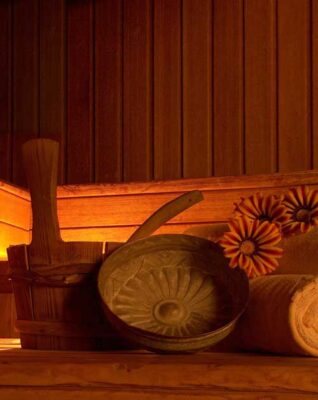Articles
About saunas

When we talk about saunas we usually think of the type of sauna that has its
origins in Finland – a small room or building where you can take a dry or steamy “bath” at very high temperatures. This type of sauna has a long history and although the word sauna is derived from Finnish, the sauna itself has been used all over the world since mankind learned to build.
All over the world you will find variants of “sweat lodges”, where different cultures have taken advantage of the benefits of sweating thoroughly and reap the benefits of heating the body at the same time.
The Indians of the highlands of Central America called the sauna a temazcal. Archaeological finds in Greenland and Newfoundland show that the saunas used there were very similar to the northern European ones. In Europe, it is the Nordic countries that are known for their saunas, which makes good sense in countries that have harsh winter climates.
The difference between a traditional sauna and a steam bath is the combination of air temperature and humidity. In a steam bath, where the humidity can be up to 100 %, the temperature must not exceed 40 ° C – otherwise you risk scalding.
The temperature of the air in a Sauna remains above the dew point (the temperature at which water vapor in the air is turned into liquid). Therefore, the air will feel dry, as the user’s own body temperature is below the dew point, and the water condenses on the skin, creating the feeling of hot steam.
In addition to prefabricated saunas, which are delivered as assembly kits, Nordkap Living also sells materials for the manufacture of saunas from scratch. The quality requirements for our self-build materials are the same as for the finished cabins.
Construction of a modern sauna
Basically, a sauna is a room made of wood with a couple of benches and a sauna heater to warm up the air.
Under/behind the sauna heater is an air intake where cold air enters from outside. When the sauna heater is switched on, the heated air rises above the heater and draws the cold air through the heater, raising the temperature of the cold air.
The now hot air circulates around the room. Opposite the heater (as far away from the stove as conditions allow) and close to the floor, there is an air outlet that allows fresh air to enter the cabin without losing too much heat in the process. The vent must be close to the floor to prevent freshly heated air from escaping immediately.

It is important to pick the right type of wood for your sauna.
The most suitable wood is fine-grained and knot-free. The fine structure allows the wood to withstand the extreme temperature fluctuations, to which a sauna is exposed.
Low annual growth provides the vein density that makes wood suitable for sauna use. Nordkap Living buys aspen wood for self-builders from the Baltic countries, where severe cold and short summers provide just the right growth conditions.
Not all wood from the appropriate types of wood is equally suitable. Therefore, it is sorted into classes according to quality. Nordkap Living only buys class A-graded wood, which is the highest ranking. This is your assurance that you are getting the best wood for your sauna.
Aspen
Aspen has a beautiful uniform surface and, light colors and low weight. The wood is very stable in shape and does not contain much resin, which, when heated, can melt and run out. It has a weak heat conduction, meaning it will not feel hot when touched, regardless of whether the sauna has been heated for a long time. Aspen retains its color even after a long period of time.
Heat-treated aspen
Heat treatment increases the quality of the wood even more. Aspen is already particularly suitable for saunas, and the gentle heat treatment gives the wood a slightly darker, warmer glow. The color changes homogeneously in the wood, so it is not only the surface that darkens.
Heat-treated wood is dirt-repellent and smooth. The heat treatment makes aspen even more form-retaining and increases its durability.
The wood gets drier, and therefore lighter, without losing strength. Less moisture in the wood also gives better insulating abilities and the wood does not shrink. It keeps its shape and does not create leaks, as the wood does not “work” as much.
All this is achieved by a chemical-free, nature-friendly heat treatment.

Red alder
Red alder is used as a cheaper alternative to aspen. It does not have the same good properties as sauna wood as aspen, and therefore it is even more important for you to get A-graded wood.
Red alder can have brownish spots in the wood that originate from passages caused by the larvae of the marrow spot fly.
Canadian hemlock
Our indoor saunas are built of Canadian hemlock wood which is particularly

suitable as a sauna wood. It has a homogeneous color and fine structure giving a beautiful look in itself. Hemlock is by nature a very durable wood that is resistant to fungus and rot.
Hemlock used for our indoor saunas comes from sustainable forestry and is FSC-certified.
Cedar
Nordkap Livings outdoor saunas and hot tubs are made of cedar, a wood species that, in addition to meeting the above mentioned requirements for dense veins, also has a natural resistance to rot, fungus and insect infestation. Cedar has a beautiful reddish color that, with the right treatment, can last for a very long time. Cedar is also an aromatic type of wood with a pleasant scent.
The cedar, we use, is PEFC-certified “Western Red Cedar” from sustainable forestry in Canada.
The wood has an unusual durability. Thanks to this, the best grades are used in construction. The durability can be extended through treatment with an oil seal.
Cedar is maintained with a wax oil treatment once or twice a year.
Certification
Certification of sustainable forestry is given through several different bodies. The purpose of the certification is to secure the forests of the world from ruthless over production, and to ensure that we have good types of wood available in the future as well. Furthermore, we rely on forests to convert carbon monoxide to oxygen. The forests are also home to many of the Earths animal species.
FSC-certificate
FSC stands for “Forest Stewardship Council” and is an international non-profit organization that certifies the production of wood and paper as sustainable. FSC is a global brand with huge support.
You can see more about FSC on FSC Denmark’s website (in Danish).
PECF or “Program for the Endorsement of Forest Certification” is another organization with similar purposes. You can find the website of the Danish PEFC-association here (in Danish).
In line with FSC, PEFC certifies sustainable forestry.
The size of the sauna heater depends on the size of the room. The locations of air intakes and air outlets are important as well, as they determine how effectively the heated air is distributed and utilized in the room. The intake is usually placed below or close to the heater. The outtake should be as far away from the heater as possible and not too high to reduce the risk of the hot air just disappearing out of the room.
| Heater size in kW | Sauna stones in kg | Cabin area in m2 | Height of cabin in mm |
| 4,5 | 15 | 3-5 | 1900 |
| 6 | 23 | 5-9 | 1900 |
| 8 | 23 | 8-12 | 1900 |
So for example: If you have a room of 5 m2 you can choose a 4.5 or 6 kW heater.
There difference is that the 6 kW heater will heat up the room faster.
Nordkap Livings sauna heaters require a connection of 400V and a cord of at least 1½ meters.
In addition to the “small” sauna heaters, Nordkap Living also sells larger sauna heaters for professional use.
Use of water on sauna stones
Many sauna users like to pour water on the sauna stones during use. The combination of water and electronics puts great demands on the equipment. Nordkap Livings sauna heaters are manufactured by reputable manufacturers known for their craftsmanship, durability and quality. The heaters appear solid and durable, even when spraying a little too much of water on the stones. However, you should be careful never to use too much water.
Some users prefer steam in the sauna. For this purpose, we have a sauna set that contains a bucket and a ladle as well as a thermometer and hygrometer.
It is very important to remember that the ovens are made of steel, which can rust when getting wet – especially the heating elements – and that there are electrical parts below the stones that are not happy with moisture.
The ladle in the sauna set provides an appropriate amount of water to pour on the stones. If the stones are damp when you have poured water on them, you have used too much. Remember that the idea is to form steam. The water must evaporate the moment it touches the hot stones – this way you protect the heater and get the steam you want.

Sauna stones are a lava stones that is intended to retain heat from the heating elements. They help to reduce electricity consumption and extend the period of time the cabin stays heated.
The stones must be placed between the heating elements: the largest stones at the bottom, the smaller ones at the top. The stones should not be packed too tightly, as this counteracts proper heating, and should be stacked up to above the heating elements.
The heat can cause sauna stones to crack. Therefore, they should be replaced at least once a year for maximum effect. If the stones become too small, so they are too close to one another, the air cannot circulate between them – this tells you, it is time to replace the stones.

The sauna door
Nordkap Living recommends glass doors for saunas. The high temperature fluctuations in the sauna will make a wooden door work so much that it starts to bind and eventually fall apart. The warm glow from the smoky glass helps creating a comfortable atmosphere inside the cabin and it feels less confined too.
Sauna benches
Nordkap Living sauna benches for self-builders are made of ash wood, which is not as heat-absorbing as pine or spruce. Additionally, the benches are dirt-repellent, which ensures a neat and clean look for a long time, whereas light woods quickly start to look yellowish and dirty.
Benches for self-builders are available with a length of 2 meters and can be cut down to the desired length.
For those who do not want to invest quite as much, Nordkap Living also offers benches in A-grade red alder. If you want to compare the prices with our competitors, make sure that what they offer is also made of A-grade wood.
Like all other items sent by Nordkap Living, saunas are checked before dispatch. However, it is important that the buyer checks the item upon receipt and before commissioning.
Connections must be made by an authorized electrician, unless it is a product that can be connected to the socket directly.
It is the responsibility of the installer to ensure that the connection is secure and that power is supplied with the correct cables etc.
Check that the wood is intact and splinter-free before use.
Nordkap Living is not responsible for the way self-build materials are used and treated during and after the construction of a sauna. We are happy to advise, but it is the responsibility of the builder to make sure the work is carried out correctly, including how materials are used.

